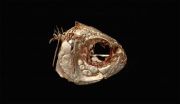(Press-News.org) Secure mobile communications underpin our society and through mobile phones, tablets and laptops we have become online consumers. The security of mobile transactions is obscure to most people but is absolutely essential if we are to stay protected from malicious online attacks, fraud and theft.
Currently available quantum cryptography technology is bulky, expensive and limited to fixed physical locations – often server rooms in a bank. The team at Bristol has shown how it is possible to reduce these bulky and expensive resources so that a client requires only the integration of an optical chip into a mobile handset.
The scheme relies on the breakthrough protocol developed by CQP research fellow Dr Anthony Laing, and colleagues, which allows the robust exchange of quantum information through an unstable environment. The research is published in the latest issue of Physical Review Letters.
Dr Anthony Laing said: "With much attention currently focused on privacy and information security, people are looking to quantum cryptography as a solution since its security is guaranteed by the laws of physics. Our work here shows that quantum cryptography need not be limited to large corporations, but could be made available to members of the general public. The next step is to take our scheme out of the lab and deploy it in a real communications network."
The system uses photons – single particles of light – as the information carrier and the scheme relies on the integrated quantum circuits developed at the University of Bristol. These tiny microchips are crucial for the widespread adoption of secure quantum communications technologies and herald a new dawn for secure mobile banking, online commerce, and information exchange and could shortly lead to the production of the first 'NSA proof' mobile phone.
INFORMATION:
Paper:
Reference frame independent quantum key distribution server with telecom tether for on-chip client
P. Zhang, K. Aungskunsiri, E. Martín-López, J. Wabnig, M. Lobino, R. W. Nock, J. Munns, D. Bonneau, P. Jiang, H. W. Li, A. Laing, J. G. Rarity, A. O. Niskanen, M. G. Thompson, J. L. O'Brien, Physical Review Letters, 2 April 2014.
This work was supported by EPSRC, ERC, QUANTIP, PHORBITEC, and NSQI.
The Centre for Quantum Photonics is a pioneering research group in the area of Quantum Technologies, it has over 70 members and grant portfolio of greater than £20million. Having invented the integrated quantum photonic chip it has already made publically accessible and available online a real quantum computer 'quantum in the Cloud' for the purposes of educating those interested in future quantum computing technologies. http://www.bristol.ac.uk/physics/research/quantum/qcloud/
Quantum cryptography for mobile phones
2014-04-03
ELSE PRESS RELEASES FROM THIS DATE:
Fermi data tantalize with new clues to dark matter
2014-04-03
VIDEO:
This animation zooms into an image of the Milky Way, shown in visible light, and superimposes a gamma-ray map of the galactic center from NASA's Fermi. Raw data transitions to...
Click here for more information.
A new study of gamma-ray light from the center of our galaxy makes the strongest case to date that some of this emission may arise from dark matter, an unknown substance making up most of the material universe. Using publicly available data from NASA's Fermi Gamma-ray ...
Which couples who meet on social networking sites are most likely to marry?
2014-04-03
New Rochelle, NY, April 3, 2014—Nearly 7% of Americans married between 2005-2012 met on social networking sites. How those couples compare to couples who met through other types of online meetings or the "old-fashioned" way in terms of age, race, frequency of Internet use, and other factors is explored in an article in Cyberpsychology, Behavior, and Social Networking, a peer-reviewed journal from Mary Ann Liebert, Inc., publishers. The article is available free on the Cyberpsychology, Behavior, and Social Networking website.
In "First Comes Social Networking, Then Comes ...
Sage grouse losing habitat to fire as endangered species decision looms
2014-04-03
As fires sweep more frequently across the American Great Basin, the US Bureau of Land Management (BLM) has been tasked with reseeding the burned landscapes to stabilize soils. BLM's interventions have not helped to restore habitat for the greater sage grouse (Centrocercus urophasianus) reported scientists from the US Geological Survey (USGS) and US Forest Service in the Ecological Society of America's journal Ecosphere last week, but outlier project sites with good grouse habitat may yield clues to successful management scenarios.
Their report arrives in the shadow of ...
Examination of a cave-dwelling fish finds a possible genetic link to human disorders
2014-04-03
Researchers have identified a genetic association with facial asymmetry in an ancient cavefish, a natural trait that may solve mysteries surrounding facial asymmetries in humans – conditions such as cleft palate or hemifacial microsomia. This exciting discovery by Joshua Gross, a University of Cincinnati assistant professor for the Department of Biological Sciences; and doctoral students Amanda Krutzler and Brian Carlson, is published in the research journal, Genetics.
The researchers are studying the craniofacial features of the eyeless, cave-dwelling fish, Astyanax ...
Synergy of high protein intake and exercise in youth enhances bone structure and strength
2014-04-03
A study presented during the World Congress on Osteoporosis, Osteoarthritis and Musculoskeletal Diseases in Seville shows that high levels of protein intake (HProt) enhance the positive impact of high physical activity (HPA) on bone structure and strength in healthy pre-pubertal boys.
Researchers from the University of Geneva in Switzerland and Eindhoven University in the Netherlands tracked 176 healthy pre-pubertal boys (average age 7.4 years) to mid-adolescence (average age 15.2 years). Compared to moderate protein intake, HProt in combination with HPA was associated ...
Adults' tonsillectomy complications are higher than previously thought
2014-04-03
Twenty percent of adults who have tonsillectomies will have a complication, which is significantly higher than previously shown, according to a team of researchers. The team also found that these complications substantially increase health care expenditures.
"Since 1973, John Wenneberg and his colleagues at Dartmouth have been examining variation in the rates of tonsillectomy performed across regions, trying to explain why such wide variation is observed," said Dennis Scanlon, professor of health policy and administration, Penn State. "In other words, why are some patients ...
Report documents cardiopulmonary arrest in premature infant after cyclomydril eyedrops
2014-04-03
San Francisco, CA, April 2, 2014 – Eyedrops administered to infants as part of routine outpatient retinopathy of prematurity (ROP) screening can have life-threatening consequences. A case report published in the current issue of the Journal of the American Association for Pediatric Ophthalmology and Strabismus (AAPOS) describes cardiopulmonary arrest in a 27-week-old infant following administration of three sets of cyclopentolate 0.2%/phenylephrine 1% (Cyclomydril) eyedrops.
"Cardiopulmonary arrest can occur from just instillation of eyedrops in a premature infant seen ...
Drawing conclusions
2014-04-03
Is a picture worth only a thousand words? According to Dr. Carmit Katz of Tel Aviv University's Bob Shapell School of Social Work, illustrations by children can be a critical tool in forensic investigations of child abuse.
Dr. Katz's study, published in Child Abuse and Neglect, compared the results when child abuse victims were offered the opportunity to draw during questioning with victims not offered this opportunity. Her findings saw a significant difference, suggesting a therapeutic value and indicating that children empowered to draw pictures about their abuse provided ...
Radium-223 dichloride in prostate cancer: Major added benefit for certain patients
2014-04-03
Radium-223 dichloride (radium-223 for short, trade name: Xofigo) has been approved since November 2013 for men with advanced prostate cancer, in whom hormone blockade is no longer effective, and symptomatic bone metastases, but without visceral metastases. In an early benefit assessment pursuant to the Act on the Reform of the Market for Medicinal Products (AMNOG), the German Institute for Quality and Efficiency in Health Care (IQWiG) examined whether this new drug offers an added benefit over the appropriate comparator therapy specified by the Federal Joint Committee (G-BA).
No ...
Nanoparticles cause cancer cells to self-destruct
2014-04-03
Using magnetically controlled nanoparticles to force tumour cells to 'self-destruct' sounds like science fiction, but could be a future part of cancer treatment, according to research from Lund University in Sweden.
Watch video:https://www.youtube.com/watch?v=vos0QW2Yclk&feature=youtu.be
"The clever thing about the technique is that we can target selected cells without harming surrounding tissue. There are many ways to kill cells, but this method is contained and remote-controlled", said Professor Erik Renström.
The point of the new technique is that it is much more ...



